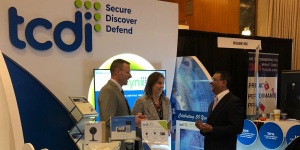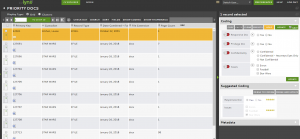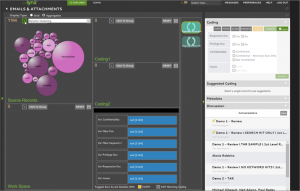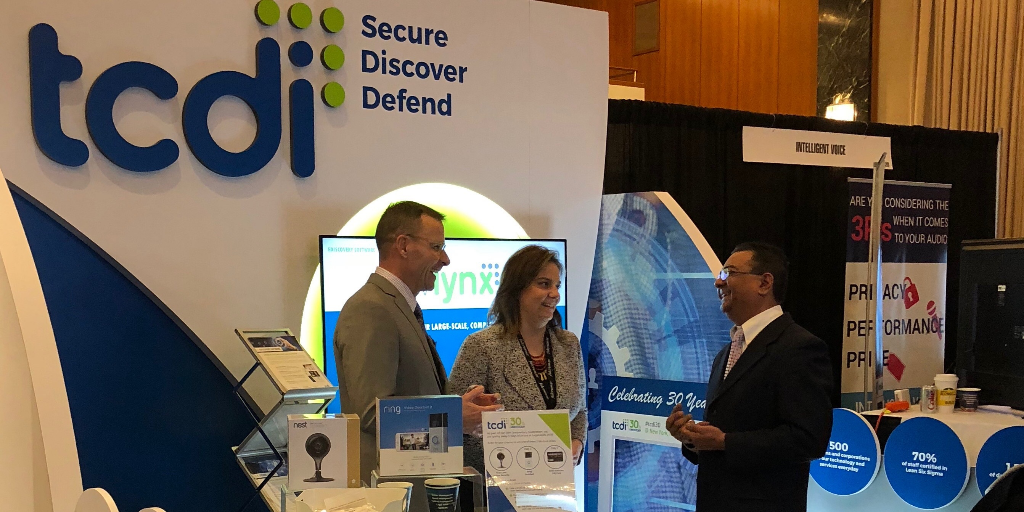Another Legaltech has come and gone! I know it’s now called LegalWeek, but to me it will always be LegalTech.
This year I was really excited to go to Legaltech. I have to admit, that it’s been a long time since I’ve been excited to go. This was my 19th show – I’ve only missed one year in my 20 year eDiscovery tenor and that was the year my daughter was born (Jan 11, 2008). The last time I was actually looking forward to the show was likely 2003 or 2004.
Now, don’t get me wrong, I love the social aspect of it – it’s great to have a lot of my clients in one place for 3 or 4 days, it’s amazing to see past coworkers and friends from all over the world, and it’s especially fun to play the ‘where are you now’ game as our industry is still very incestuous.
 At this Legaltech, I got to be one of the game pieces as I started with TCDI late last year, which is always more fun than it just being another year at the show at the same company. It was especially fun because I am now back at a technology company, not just a services company.
At this Legaltech, I got to be one of the game pieces as I started with TCDI late last year, which is always more fun than it just being another year at the show at the same company. It was especially fun because I am now back at a technology company, not just a services company.
And I think that makes a huge difference when it comes to Legaltech, at least from a vendor perspective. If you are not a creator of legal technology, then as a vendor, does it really make sense to have any real showing at Legaltech? All the reasons I mentioned earlier are reasons to go (clients, coworkers, friends, the game), but to exhibit? It’s not worth having a booth if you don’t have proprietary and interesting technology to show, or at least that’s my thinking. And since 2004, I’ve been with companies selling 3rd party tools, not creating anything, just re-packaging.
Being back on the tech side, it really was a great feeling. And this Legaltech was a big outing for us as we launched our new Efficient Review platform, CVLynx. Lynx is version 7 of the ClarVergence tool (affectionately known as CV), and so we had stuff to show and stuff to talk about to people. It was cool.
Along with the preparing for the launch of CVLynx, we’ve spent a lot of time thinking about how to redefine the document review process. So much technology and features have been thrown into the mix to augment the process at various stages, but we realized that how we think about the people and process of document review also needed to change: how we review, who reviews and when you review.
The potential for multi-million document reviews grows every year for companies, so we, at TCDI, put our hand up and asked, “Want to try something different?”. The people we met with at Legaltech seemed ready to give it a try.
Redefining Document Review – The Grid
Everyone loves the grid – the list of documents you get when you open a folder or run a search. You know it, and you probably love it. Me? I hate the grid. Well, actually, I don’t always hate the grid. I think there is a time and a place for it, but starting with the grid lacks imagination. It lacks creativity.
 Now, don’t panic, we have a grid. So if you really want that comfort level of going doc by doc, go ahead, it’s there. We did, however, add some tools and formatting to increase efficiency and allow the reviewer to see more, or less, depending on how you look at it. We created a grid that shows the reviewer everything they could want to see when making a decision on a document, and we put it all in one place, one very easy to read, easy to see place, so you don’t have to switch between windows, launch various viewers, scroll down field lists, etc. Unless you want to, that’s still an option, but we hope you don’t want to because we have found a better way for you.
Now, don’t panic, we have a grid. So if you really want that comfort level of going doc by doc, go ahead, it’s there. We did, however, add some tools and formatting to increase efficiency and allow the reviewer to see more, or less, depending on how you look at it. We created a grid that shows the reviewer everything they could want to see when making a decision on a document, and we put it all in one place, one very easy to read, easy to see place, so you don’t have to switch between windows, launch various viewers, scroll down field lists, etc. Unless you want to, that’s still an option, but we hope you don’t want to because we have found a better way for you.
We also added copy and paste coding functionality to the grid so that when you review the first in a series of similar documents carefully and code it appropriately, you can copy that coding and apply it to the remaining documents that you already know are going to be similar. You can paste coding with one click, rather than re-clicking for Responsiveness, Privilege, Issues, Confidentiality, etc. with each similar document. Save Clicks! This also promotes better consistency, because you’re reducing the opportunity for human error with miss-clicks or inconsistent coding choices.
So, we still have the grid, but we made huge improvements to it. And that redefines the grid, but that still doesn’t really change the overall process. Enter Clusters.
Redefining Document Review – Clusters
With our new efficient Review, we tried to think of the Reviewer themselves and how they can review documents in a way that makes sense to the outcome: produce Responsive documents, don’t produce Privileged documents and limit the Not Responsive that goes out the door. Keeping that outcome in mind, forgetting the grid, is how our Clusters view came to be.
The reviewer population today consists mainly of people under the age of 40, most falling in the 26-30 range, or that has been our experience anyway. These are people who have a lot of drive and energy, are used to technology making things easier, and are gamers and strategists who prefer to see the world visually rather than textually.
 The Grid is boring to this new type of document reviewer, and it doesn’t make sense. The Grid is too much of a straight line, and it’s not overly helpful when it comes to telling a story. So, for this generation of document reviewer, we took the time to redefine how they can do document review, and it’s not like how their older compatriots are used to doing it. We created a Clusters view which allows these reviewers to decide how they review documents autonomously. We think of it as the gamification of document review, and we know it will resonate with this new breed of reviewer.
The Grid is boring to this new type of document reviewer, and it doesn’t make sense. The Grid is too much of a straight line, and it’s not overly helpful when it comes to telling a story. So, for this generation of document reviewer, we took the time to redefine how they can do document review, and it’s not like how their older compatriots are used to doing it. We created a Clusters view which allows these reviewers to decide how they review documents autonomously. We think of it as the gamification of document review, and we know it will resonate with this new breed of reviewer.
Clusters allow the reviewer to re-engage in document review and use powerful visualizations. This approach gives them the ability to take their assigned documents and decide: how they want to review them; what makes the most sense for them; how they can find the best groupings of documents. As a manager, I want to assign groups of documents to reviewers, but should I care how they review after that as long as they are efficient, consistent and accurate? In Clusters view, the reviewer regains the ability to think for themselves.
Redefining Document Review – Review Rooms
Outside of TCDI, a day in the life of a reviewer looks like this today. They come in at the start of the day, open the review tool, check out a batch and then go document by document and review the documents in their batch in accordance with the Review protocol and training they’ve been given. They sit at their desk, and they stare at their dual monitors for hours at a time, getting up every now and again to get a drink, stretch their legs or use the restroom. Their eyes, their minds and their bodies tire throughout the day. Their eyes and minds tire quicker than the rest, because it is exhausting to read documents all day long.
Another way we are redefining document review is by giving the reviewer a more comfortable and inviting space in which to do document review. At TCDI’s offices, we take this same stance when it comes to all employees, including in the document review centers. Everyone has a desk to work at, but we also have comfy sofas and laptops available for team members, we have armchairs with laptop tables, we have counter seats and the desks are sitting/standing desks. We enjoy flexibility in seating and comfort in our non-work environments, and we strongly feel we should enjoy that same flexibility at work. All of us, including document reviewers.
We also have an option for remote reviewers that we refer to as ‘your living room or ours’. If you do not live near one of our review centers, we have created an onboarding/background screening process and a secure access pathway that allows for reviewers to work from their own homes while still complying with our clients’ high security standards. This option to work remotely is available to those who pass our various test and screens, and it allows TCDI to offer a richer talent base of reviewers than is historically the case when limited by geography.
Redefining Document Review
Combining the new improvements to the grid, giving reviewers the ability to re-engage in document review through a much more intuitive and interesting review module and then, on top of that, making sure they are comfortable while doing it, are some of the most important ways we are redefining document review.
And presenting all of this at Legaltech is why I was so excited to go to the show this year. I’m happy to say that I didn’t see any other exhibitor talking about changing the process of document review or how to solve the problem of document review and I definitely didn’t see any other review platforms pushing for reviewer autonomy.
Save Clicks!





